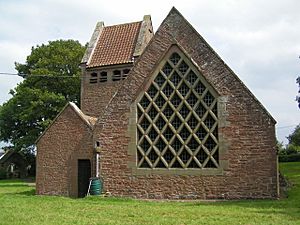St Edward's Church, Kempley facts for kids
The Church of St Edward the Confessor is a special church in Kempley, a village in the Forest of Dean area of Gloucestershire, England. It's very close to the border with Herefordshire. This church belongs to the Church of England.
Quick facts for kids Church of St Edward the Confessor |
|
|---|---|
 |
|
| 51°57′50″N 2°28′47″W / 51.9640°N 2.4798°W | |
| Country | England |
| Denomination | Church of England |
| Churchmanship | Broad Church |
| History | |
| Status | Active |
| Architecture | |
| Functional status | Parish church |
| Heritage designation | Grade II* listed |
| Administration | |
| Parish | Kempley |
| Deanery | North Cotswold |
| Archdeaconry | Archdeaconry of Cheltenham |
| Diocese | Diocese of Gloucester |
Contents
A Church with a Story
This church was built between 1903 and 1904. It was designed by an architect named Randall Wells. The building is so important that it has a special heritage status called Grade II* listed. This means it's a very important historical building, but not quite as important as a Grade I listed building. A famous writer, John Betjeman, once called it "a mini-cathedral of the Arts and Crafts movement".
Why Was It Built?
The church is dedicated to Edward the Confessor, a king of England. It was built by the local landowner, William Lygon, 7th Earl Beauchamp. He wanted a new church because the older one, St Mary's Church, Kempley, was too far away for many people in the village. Also, St Mary's was often flooded. So, St Edward's was built as a "chapel of ease." This means it was a smaller church built to help people who couldn't easily get to the main parish church. In 1975, St Edward's became the main parish church.
How It Was Designed
Randall Wells had worked with another architect, William Lethaby, on a church called All Saints' Church in Brockhampton-by-Ross. Lethaby liked to try new ways of building. Instead of using a big building company, he used local workers directly. He also didn't make many detailed drawings. This gave Wells a lot of freedom to change the design as the church was being built. He could even help with the actual building work!
Wells was asked to design the church to fit on foundations that were already started. Lord Beauchamp had some specific ideas. He didn't want a window on the east side of the church. Most of the light had to come from the west side. He also wanted the roof edges (eaves) to be kept low.
Kempley is a small village, but it's special because it has two important Anglican churches. The other, older one, St Mary's, is even more important and is a Grade I listed building.
Outside the Church
The Church of St Edward the Confessor was built using materials found nearby. Local people did the building work. The red sandstone used for the walls came from quarries in the Forest of Dean, about seven miles away. The wooden beams for the roof were made from oak trees cut down on the Beauchamp estate. These trees were "unseasoned," meaning the wood was used fresh, not dried out.
The church roof was originally covered with local stone slates. You can still see these slates on the lych gate, which is a covered gateway to the churchyard. However, the church roof itself now has pantiles, which are S-shaped roof tiles.
Inside the Church
Inside the church, you can see three beautiful stone carvings. These were designed by Randall Wells himself.
- Above the entrance, there is a carving of Christ. This was carved by Wells and a local carpenter named Walter James.
- Inside the porch, there is a carving of the Virgin and Child by an artist named Laurence Turner.
- On the East wall, you can see a carving of the Crucifixion, also made by Walter James.
The rood is a large cross or crucifix that stands above the entrance to the chancel (the area near the altar). The rood in this church was carved by David Gibb. He was from Glasgow and was said to be the last person in London who carved ship's figureheads. Randall Wells and his brother Linley painted the rood.
The seating, the prayer desk, the rails, and the altar were all designed by the architect. They were made from English oak by Peter Waals at the Daneway Workshop. This workshop was part of a partnership between Ernest Gimson and Ernest Barnsley, who were famous for their Arts and Crafts furniture. The lectern, where the Bible is read, was designed by Barnsley. The candelabra (candle holders) and a pair of iron candlesticks were made by Alfred Bucknell. Other ironwork was done by the village blacksmith in Kempley, George Smallman.
In March 2011, the church council started an appeal to raise money for repairs. They needed £110,000 to help fix up the church.
Gallery






